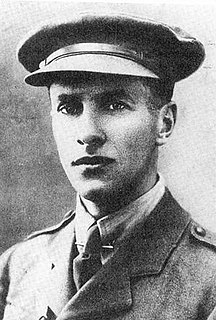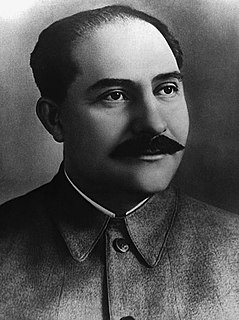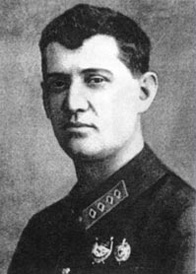 W
WThe Holodomor, also known as the Terror-Famine and sometimes referred to as the Great Famine, was a famine in Soviet Ukraine from 1932 to 1933 that killed millions of Ukrainians. The term Holodomor emphasises the famine's man-made and intentional aspects such as rejection of outside aid, confiscation of all household foodstuffs and restriction of population movement. As part of the wider Soviet famine of 1932–1933 which affected the major grain-producing areas of the country, millions of inhabitants of Ukraine, the majority of whom were ethnic Ukrainians, died of starvation in a peacetime catastrophe unprecedented in the history of Ukraine. Since 2006, the Holodomor has been recognized by Ukraine and 15 other countries as a genocide of the Ukrainian people carried out by the Soviet government.
 W
WThis is a select bibliography of post World War II English language books and journal articles about Stalinism and the Stalinist era of Soviet history. Book entries have references to journal reviews about them when helpful and available.
 W
WBlacklisting, or the system of the chorna doshka synonymous with a "board of infamy", was one of the elements of agitation-propaganda in the Soviet Union, and especially Ukraine and the ethnically Ukrainian Kuban region in the 1930s, coinciding with the Holodomor, the artificial famine imposed by the Soviet regime as part of a policy of repression. Blacklisting was also used in Soviet Kazakhstan.
 W
WThe causes of the Holodomor, the famine that ravaged Soviet Ukraine during 1932 and 1933, killing between 4 million and 12 million individuals, are the subject of scholarly and political debate. Some historians believe the famine was the unintended consequence of problems arising from agricultural collectivisation implemented to support the program of rapid industrialisation in the Soviet Union under Joseph Stalin. Other historians believe policies were intentionally designed to cause the famine. Some suggest that the famine may fall under the legal definition of genocide.
 W
WVlas Yakovlevich Chubar was a Ukrainian Bolshevik revolutionary and a Soviet politician. Chubar was arrested during the Great Terror of 1937-38 and executed early in 1939.
 W
WThe Soviet Union implemented the collectivization of its agricultural sector between 1928 and 1940 during the ascension of Joseph Stalin. It began during and was part of the first five-year plan. The policy aimed to integrate individual landholdings and labour into collectively-controlled and state-controlled farms: Kolkhozy and Sovkhozy accordingly. The Soviet leadership confidently expected that the replacement of individual peasant farms by collective ones would immediately increase the food supply for the urban population, the supply of raw materials for the processing industry, and agricultural exports via state-imposed quotas on individuals working on collective farms. Planners regarded collectivization as the solution to the crisis of agricultural distribution that had developed from 1927. This problem became more acute as the Soviet Union pressed ahead with its ambitious industrialization program, meaning that more food needed to be produced to keep up with urban demand.
 W
WCollectivization in Ukraine, officially the Ukrainian Soviet Socialist Republic, was part of the policy of collectivization in the USSR and dekulakization that was pursued between 1928 and 1933 with the purpose to consolidate individual land and labour into collective farms called kolkhoz and to eliminate enemies of the working class. The idea of collective farms was seen by peasants as a revival of serfdom.
 W
WDenial of the Holodomor is the false claim that the 1932–1933 Holodomor, a large-scale, man-made famine in Soviet Ukraine, did not occur or diminishing the scale and significance of the famine. Officially the Soviet Union denied the famine and suppressed information about it from its very beginning until the 1980s. This was also circulated by some Western journalists and intellectuals. It was echoed at the time of the famine by some prominent Western journalists, including The New York Times' Walter Duranty.
 W
WWalter Duranty was an Anglo-American journalist who served as Moscow bureau chief of The New York Times for fourteen years (1922–1936) following the Bolshevik victory in the Russian Civil War (1918–1921).
 W
WIvan Dziuba is a Ukrainian literary critic, social activist, Russian philologist, dissident, Hero of Ukraine, academic of National Academy of Sciences of Ukraine, the second Minister of Culture of Ukraine (1992—1994), Head of the Committee for Shevchenko National Prize (1999–2001).
 W
WThe Holodomor Memorial to Victims of the Ukrainian Famine-Genocide of 1932–1933 was opened in Washington, D.C., United States, on November 7, 2015. Congress approved creation of the Holodomor Memorial in 2006.
 W
WThe Holodomor genocide question is an attempt to determine whether the Holodomor was an ethnic genocide against Ukrainians. In 1932–1933, a famine killed 3.3–3.9 million people in the Ukrainian Soviet Socialist Republic, included in a total of 5.5–6.5 million killed by the broader Soviet famine. At least 3.3 million ethnic Ukrainians were among the victims.
 W
WThe Holodomor was a famine in the Ukrainian Soviet Socialist Republic and adjacent Cossack territories between 1932 and 1933, in which millions of Ukrainians died from starvation. Opinions and beliefs about the Holodomor vary widely among nations; it is considered a genocide by Ukraine and fifteen out of 195 other nations, a crime against humanity by the European Parliament, and part of the Soviet famine of 1932–1933 by the Russian Federation.
 W
WThe International Commission of Inquiry Into the 1932–1933 Famine in Ukraine was set up in 1984 and was initiated by the World Congress of Free Ukrainians to study and investigate the 1932-1933 Famine in Ukraine. Members of Commission selected and invited by World Congress of Free Ukrainians. None of them represent own country or country authority/institution and act as individual. Most of them are retired jurists, one of them died before Commission finish their investigations. The Commission was funded by donations from the worldwide Ukrainian diaspora.
 W
WGareth Richard Vaughan Jones was a Welsh journalist who in March 1933 first reported in the Western world, without equivocation and under his own name, the existence of the Soviet famine of 1932–33, including the Holodomor.
 W
WLazar Moiseyevich Kaganovich, also Kahanovich was a Soviet politician and administrator, and one of the main associates of Joseph Stalin. He is known for helping Stalin come to power and for his harsh treatment and execution of those deemed threats to Stalin's regime.
 W
WMykola Lemyk was a Ukrainian political activist and leader of the Organization of Ukrainian Nationalists (OUN).
 W
WNational Museum of the Holodomor-Genocide, formerly known as the Memorial in Commemoration of the Holodomor-Genocide in Ukraine, is Ukraine's national museum and a world-class centre devoted to the victims of the Holodomor of 1932-1933. The museum was opened on the day of the 75th anniversary of the Holodomor in 2008 and gained the status of a national museum in 2010. The museum is located on the Pechersk Hills on the right bank of the Dnieper river in Kyiv, adjacent to the Kyiv Pechersk Lavra.
 W
WGrigory Ivanovich Petrovsky was a Ukrainian Soviet politician and Old Bolshevik. He participated in signing the Treaty on the Creation of the USSR and the Treaty of Brest-Litovsk. Petrovsky was one of the officials responsible for implementing Stalin's policies such as collectivization.
 W
WStanislav Frantsevich Redens was a Soviet NKVD official, one of those responsible for conducting mass repressions under Joseph Stalin. Redens was himself executed in 1940, after being arrested at the end of the Great Purge in 1938.
 W
WThe US Commission on the Ukraine Famine was a commission set up by Senate resolution S2458 on September 21, 1984. The 99th Congress, on January 3, 1985, passed appropriations to fund the Famine Commission and on April 23, 1986, the Commission held its organizational meeting at the Rayburn House Office Building "to conduct a study of the 1932–33 Ukrainian Famine in order to expand the world’s knowledge of the famine and provide the American public with a better understanding of the Soviet system by revealing the Soviet role". Its findings were delivered to the US Congress on April 22, 1988. The final report to Congress found that the man-made famine was an act of genocide against the people of Ukraine carried out by the Soviets. At its final meeting on April 19, 1986, Commissioner Ulana Mazurkevich condemned the actions of Walter Duranty, who knowingly sent out false dispatches about the famine to The New York Times.
 W
WWorld Without Nazism (WWN), or Mir Bez Natsizma (MBN), is a Russian political organization with ties to Vladimir Putin's government, which claims to campaign against "neo-fascism." The group has also been described, by security agencies from the Baltic republics, as a Russian propaganda organization, and as a Kremlin-sponsored GONGO, which aims to advance Russian foreign policies against formerly Soviet-occupied countries and to promote "a Soviet-era approach to World War II". The organization was founded and is led by Boris Spiegel, a Russian oligarch with close ties to Putin. It was founded in Kyiv, Ukraine, on 22 June 2010, and is registered in Strasbourg, France.